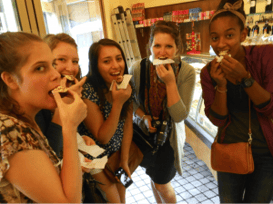-1.jpg)

There are a lot of ideas floating around out there about what life in Italy is like: stereotypes (flattering and not-so-flattering ones), exaggerations (think: the gesticulating Italian with hands waving madly), and some downright myths. Here are 5 myths about Italy that I've actually heard from friends or family back home:
1. There is nothing to eat besides pasta and pizza.
Many travelers, prior to arriving to Italy, believe that meatballs are everywhere and people are sharing spaghetti Lady and the Tramp-style. Or that pizza in Italy is like Pizza Hut, just better.
First of all, spaghetti and meatballs is not a typical Italian dish. Italians don’t generally mix their meatballs and pasta; meatballs is normally served separately (polpette) as a secondo, a second course. Another surprise to many is that Italian pizza is nothing like Pizza Hut, Papa John's, or whatever your pizza of choice is back home. Forget deep-dish, mozzarella-stuffed crust, ordering a pizza with "the works", or crazy toppings like pineapple (and I say this as someone who loves pineapples on my pizza). Italian pizzas are often much simpler with a simple crust (flat and crispy is Roman style) and just a few good-quality, fresh toppings.
Moreover, Italian cuisine isn’t restricted to just pizza and pasta. There's risotto, meat and poultry, fish, minestra, vegetable dishes... the list goes on. The best steak I ever had was in Florence, where you can never go wrong with a bistecca fiorentina.

2. Everyone is fashionable, always.
Fashion is very prevalent in Rome and other parts of Italy. I have never attended such a well-dressed school, and am often in awe of some of the outfits my fellow John Cabot University classmates put together. Although Rome raises the bar in terms of fashion in comparison to other cities I have lived in, all Italians aren’t always dressed to the nines. It is okay to wear sneakers, jeans, and a t-shirt; many locals wear this as well. The social rules of what to wear in public can also vary with whom you speak to. Maybe an Italian grandma (nonna) would tsk-tsk at the sight of flip-flops in the city, while a younger Italian would think nothing of it.
3. If you see Rome, Florence, and Venice, you've "done" Italy.
Wrong, wrong, wrong! There is so much more to see! Just to name a few: the Amalfi Coast, Capri, Palermo, Lake Como, Sardegna, Milan, Turin, Naples, Bologna.... Although the “major three” do have a lot to offer in terms of history, museums, monuments, and culture, there are other cities that are too often overlooked. The country is full of amazing cities, towns, countryside, lakes, mountains, and shoreline from the north to the south. Lake Como had the most dramatic and breathtaking scenery I have ever seen. The best food I have tasted was in Palermo, Sicily - I still think about their arancini (stuffed, breaded, and fried rice balls) and cannoli to this day.
4. It is difficult to travel around Italy.
Yes, it can be overwhelming to make your way around a new country, but I promise, it is actually pretty easy! Rome public transportation is not something I would write home about, but in terms of getting from city to city it is simple. Italy is smaller than the state of California (crazy, huh?) and it doesn’t take a lot of time to travel around the country. Rome has many train stations, such as the one close to JCU, Trastevere station, which can take you to all corners of the boot. There are also cheap flights if you want to get there even faster. For example, I once flew from Rome to Palermo for a total of 48 euros.
5. You have to speak Italian to get around.
Although I highly recommend taking language courses prior to visiting Italy, it is not necessary. In Rome many Italians, especially younger Italians, speak at least some English. Since the city thrives on tourism, Italians are used to hearing and responding in English. I do think if you are studying abroad or enrolling at JCU for your undergrad career, it is important to make an effort to learn the language; it is a wonderful skill to have, locals will appreciate your effort (even if you still can't pronounce amatriciana to save your life), and you'll feel more at ease in a new country!

Carly Newgard
Communications major, Humanistic Studies minor
Class of 2017
Hometown: San Diego, California




